Bulk-generate & schedule posts in seconds with Smart Scheduling. Try now!
Content marketing ROI: A guide to measuring your success
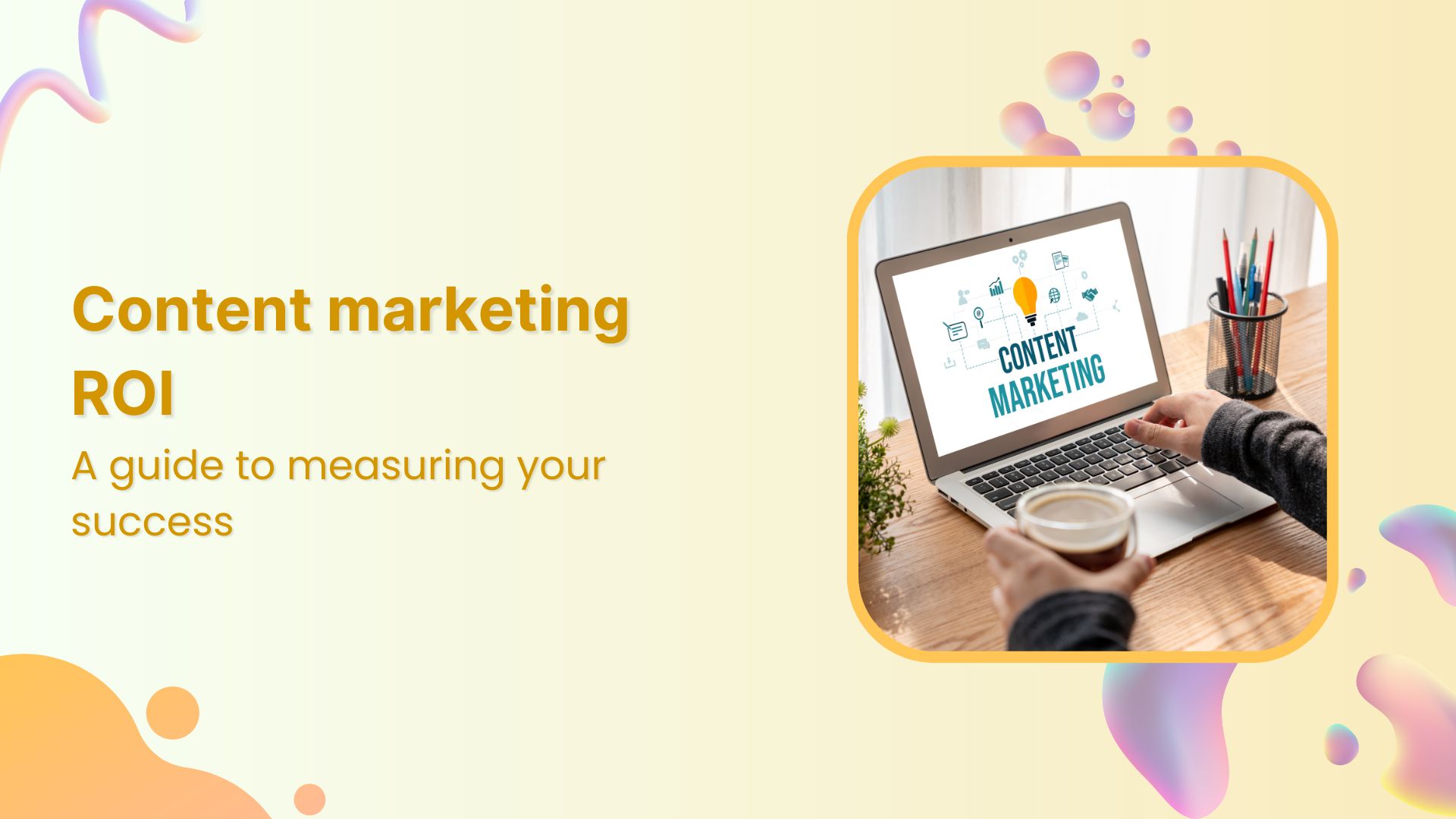
Evaluating the effectiveness of your marketing campaigns through content marketing ROI is increasingly critical. Yet, according to a recent CMO Survey, a staggering 65% of marketers struggle to quantitatively demonstrate the impact of their marketing efforts.
With an increasing focus on data-driven strategies, the pressure to measure content marketing’s return on investment (ROI) has never been higher. As we shift past the scattergun approach to marketing, understanding and proving the value of your content efforts is essential.
This guide aims to shed light on how to measure content marketing ROI effectively, ensuring your investments are driving the desired outcomes and contributing to your business growth.
What is content marketing ROI?
Content marketing ROI quantifies the revenue generated from content marketing activities relative to the amount spent on creating and distributing that content. It answers: “Is the money and time invested in content marketing yielding tangible benefits for my business?” Understanding this metric helps identify the value derived from your efforts.
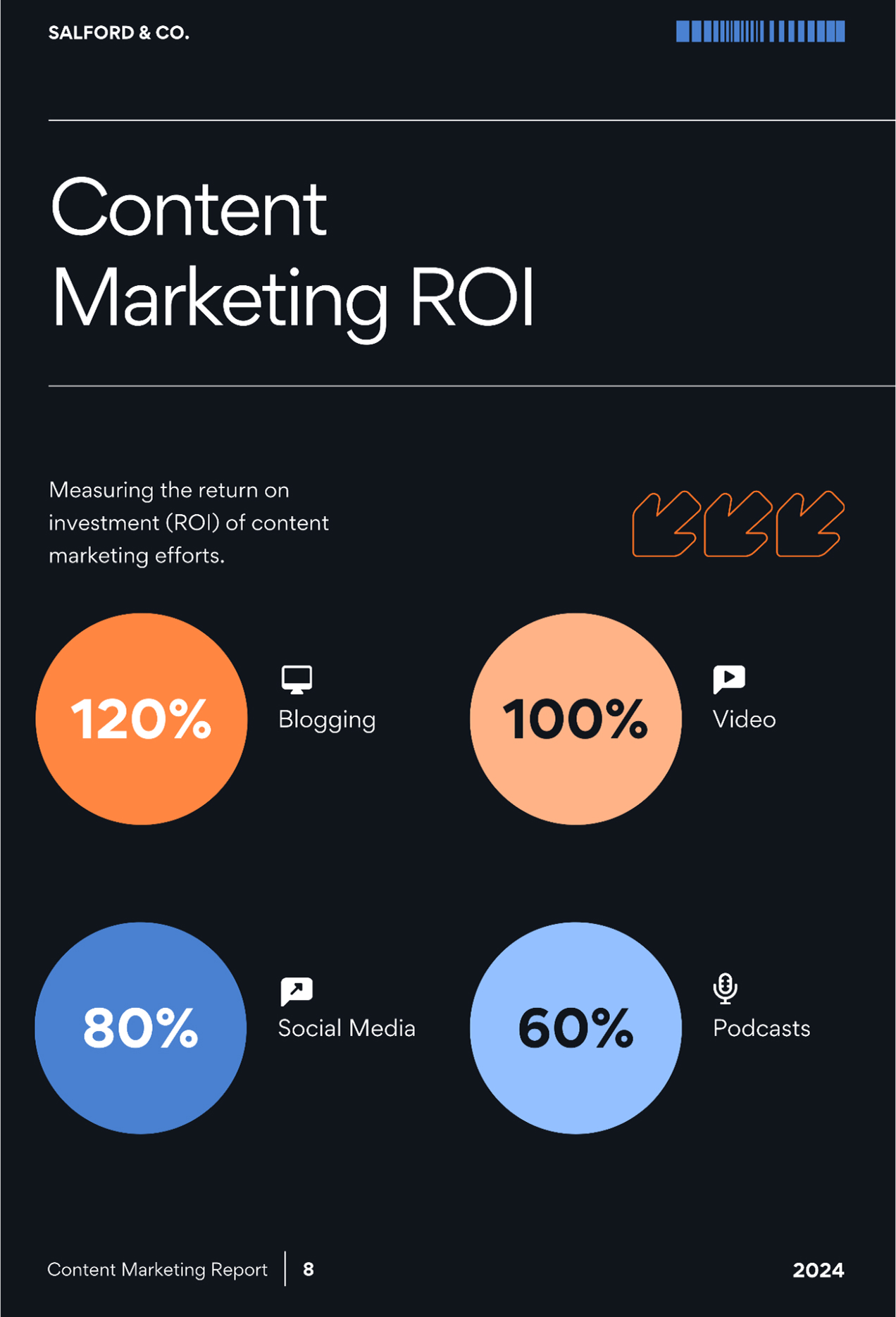
Content marketing ROI goes beyond immediate financial gains. It includes increased brand awareness, lead generation, enhanced customer engagement, and long-term loyalty.
The formula is straightforward:
Content Marketing ROI = (Return−Investment/Investment)×100
- Return: Includes all revenue generated from leads acquired through content marketing, as well as any measurable increases in brand value or customer loyalty.
- Investment: Includes all expenses related to content creation and distribution, such as writer and designer fees, software subscriptions, advertising costs, and overheads.
For example, an online fitness coaching business invests $1,000 monthly in content marketing. Over a year, this results in 1,000 new leads, with 20% converting into paying clients. If each client generates $500 in monthly revenue and remains loyal for an average of 12 months, the total revenue can be calculated. By applying the ROI formula, you can determine the strategy’s effectiveness in driving business growth and profitability.
To calculate the ROI, follow these steps:
1. Calculate the total revenue:
- Number of new leads: 1,000
- Conversion rate: 20% (0.20)
- Number of paying clients: 1,000 leads * 0.20 = 200 clients
- Monthly revenue per client: $500
- Average customer lifespan: 12 months
- Total revenue from each client: $500 * 12 months = $6,000
- Total revenue from all clients: 200 clients * $6,000 = $1,200,000
2. Calculate the total investment:
- Monthly investment in content marketing: $1,000
- Annual investment: $1,000 * 12 months = $12,000
3. Calculate the ROI:
- ROI formula: ROI=(Return−Investment/Investment)×100
- Return: $1,200,000
- Investment: $12,000
- ROI=(1,200,000−12,000/12,000)×100
- ROI=(1,188,000/12,000)×100
- ROI=99
Also Read: How To Calculate Marketing ROI For Agencies?
Importance of measuring content marketing ROI
Connecting marketing efforts with business goals
It’s crucial to see how your marketing efforts align with your business goals. However, many still focus solely on tracking traffic, not the actual revenue or business impact. Surprisingly, 15% of companies have no idea why and how much they’re spending on content marketing.
To truly understand the value of your content marketing, you need to measure how it impacts your business goals, such as generating leads, acquiring customers, and increasing sales. This connection ensures that your marketing strategies are contributing to your business’s long-term growth.
Turning vague goals into measurable results
Measuring brand awareness can be tricky. A report from Parse.ly highlights that brand awareness is a top goal, but it’s hard to measure. Chima Mmeje, a content marketing expert, suggests tracking things like social media engagement, branded searches, and media mentions to measure brand awareness.
Traditional metrics like followers or likes don’t show deep engagement or customer loyalty. By linking brand awareness metrics to business goals, you can turn these vague goals into clear, measurable results.
Finding the best strategies and optimizing investments
Knowing which content marketing strategies work best is key to making the most of your budget. Not all strategies work for every business. For example, ads might not be as effective for B2B companies as they are for e-commerce, but email marketing might work well for both.
By measuring ROI, you can see which channels and strategies are the most profitable. For instance, a report showed that an automotive brand increased impressions by 26% by adjusting their media strategy. This approach is especially important when budgets are tight. Proving ROI can help you secure more funding and show that your content marketing is worth the investment.
Showing business executives the profit
Business leaders need to see clear proof that your content marketing is making money. A report found that marketers are only 54% confident in measuring ROI. This uncertainty can lead to budget cuts.
To get support from stakeholders, you need to show concrete results. This includes metrics like the revenue generated from content marketing, leads from webinars, and conversion rates. For example, if you spend $100K on content marketing, you need to show how much money it brings in. By providing clear answers about revenue and lead generation, you can prove the value of your content marketing.
KPIs in content marketing
Key Performance Indicators (KPIs) are essential for understanding and improving your content marketing efforts. By tracking these metrics, you can gauge the effectiveness of your campaigns, optimize strategies, and demonstrate the value of your content marketing to stakeholders.
To get support from stakeholders, you need to show concrete results. This includes metrics like the revenue generated from content marketing, leads from webinars, and conversion rates. For example, if you spend $100K on content marketing, you need to show how much money it brings in. By providing clear answers about revenue and lead generation, you can prove the value of your content marketing.
A social calendar not only streamlines content planning but also makes it easier to report performance to executives. By documenting what content goes out, when, and on which channels, you can clearly map content efforts to business results. This structured visibility enables better tracking of campaign timelines, performance benchmarks, and ROI, making it simpler to show leadership what’s working and justify continued or increased investment.
Here are some crucial KPIs to monitor:
1. Website visits and page views
Website visits reflect the number of times users land on your site, indicating overall traffic and interest. Page views measure the number of pages users explore during their visits. Tracking these metrics provides insights into user engagement and interaction with your content.
Increased organic traffic and higher page views suggest greater exposure and deeper engagement with your brand. Monitor visits and page views on key landing pages to assess how well your content attracts visitors and boosts brand visibility.
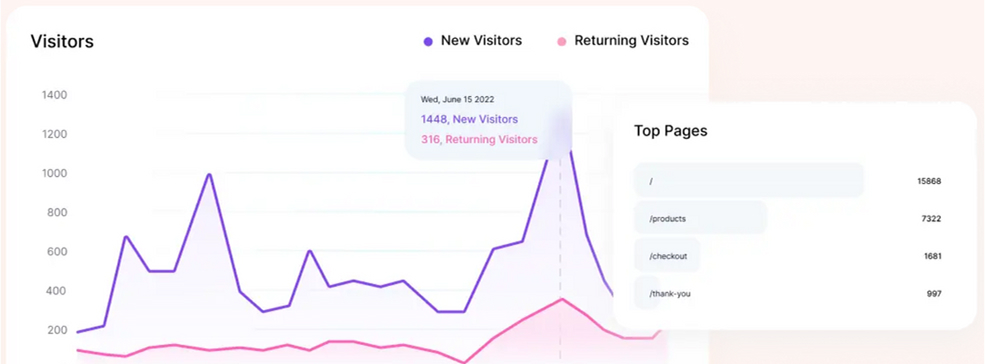
2. Social shares
Social shares occur when people share or repost your content on platforms like Facebook, Twitter, LinkedIn, and Instagram. Each share acts as a mini-vote, expanding your content’s reach and visibility.
Track which content generates high share counts to understand what resonates with your audience. Focus on who is sharing your content—industry influencers, loyal customers, or potential leads—to guide your targeting and future content strategies.

3. Tags and mentions
When people tag or mention your brand on social media, they’re discussing or referencing it in their posts or comments. Each mention boosts your brand’s visibility and shows who’s talking about you. High volumes of positive mentions indicate that your content resonates with your audience. Pay attention to influencer mentions, as they can significantly enhance your brand’s authority. Negative mentions, on the other hand, offer opportunities for improvement and building trust.
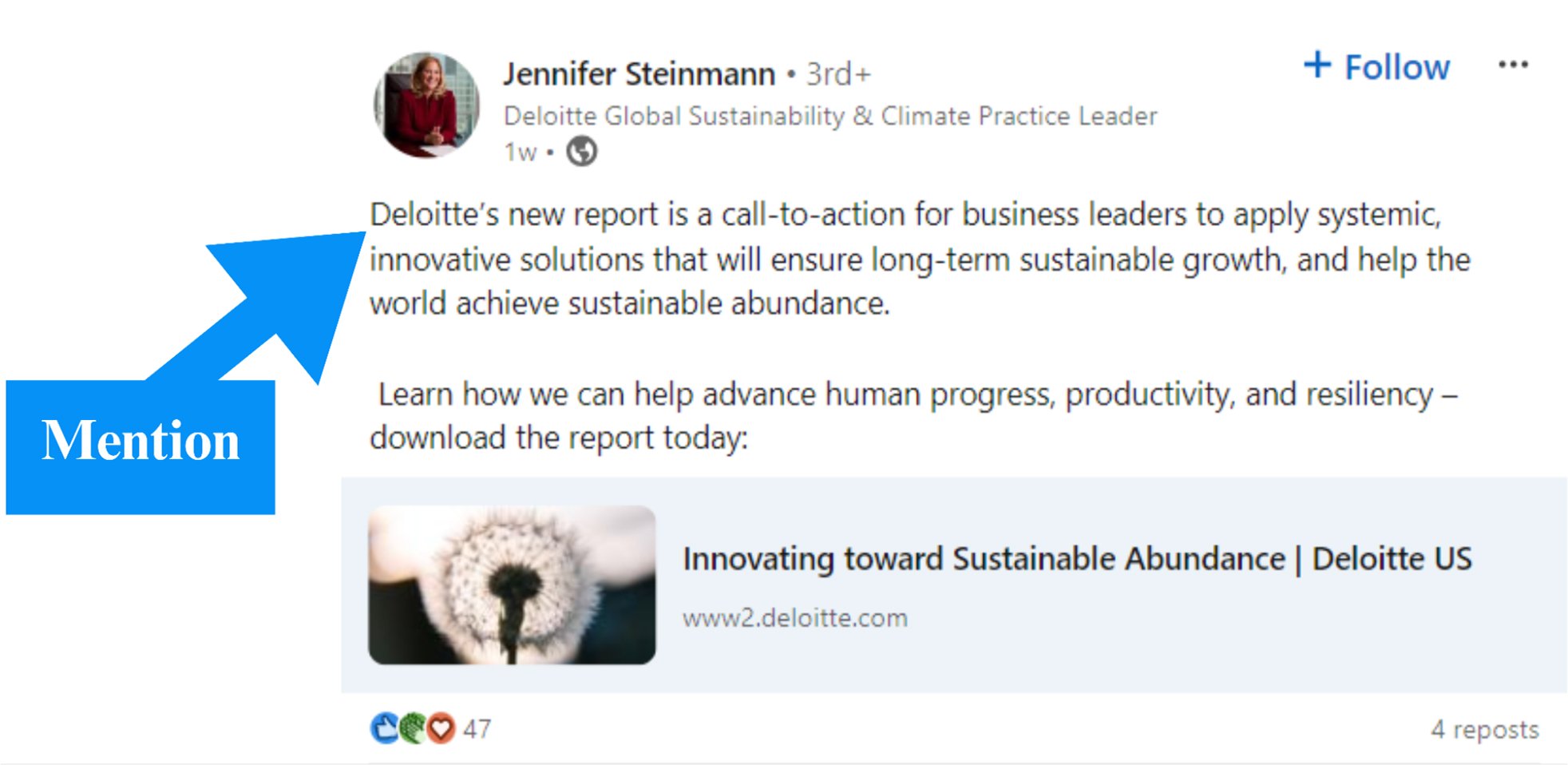
4. Referrals
Referral traffic comes from users who land on your website by clicking a link from another site, social media platform, or any online source besides a search engine. Monitoring referrals helps you understand the performance of your marketing, partnerships, and overall online presence. Use Google Analytics to track referral traffic and real-time user behavior.
Tools like Facebook, Twitter Analytics, and Instagram Insights can provide social media engagement data. Unique tracking links for each piece of content or campaign help measure performance accurately.
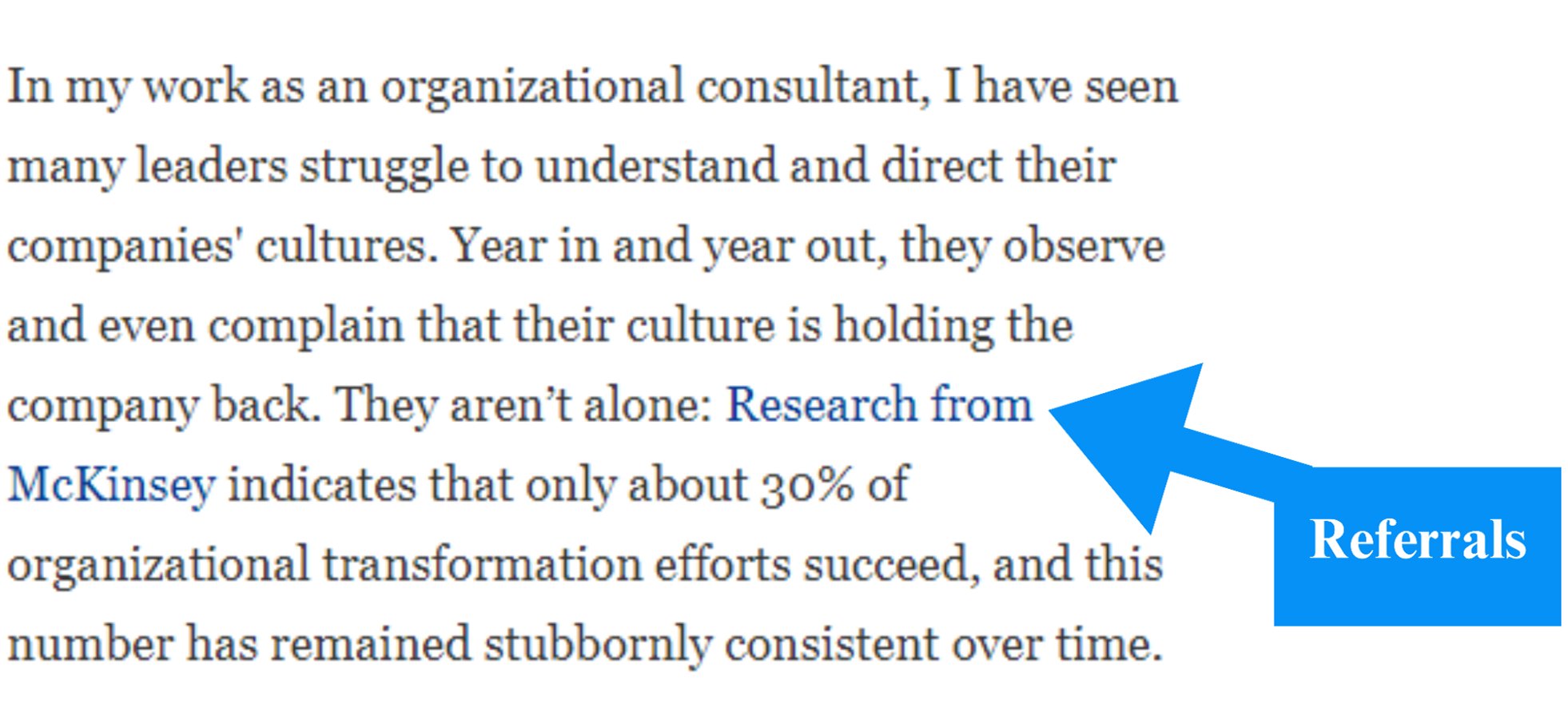
5. Average session duration
Average session duration measures how much time users spend on your site per session. Longer sessions suggest that your audience finds your content valuable, which helps build brand loyalty and trust. Track drop-off points within longer content to identify sections where interest wanes and update with more engaging material.

6. Click-Through Rates (CTRs)
Click-through rates (CTRs) measure the number of clicks a specific link receives compared to its total views. Higher CTRs indicate effective engagement, leading to lead generation or sales. Low CTRs might suggest poorly positioned or unclear calls-to-action (CTAs). Here is the formula to calculate the click-through rates.

7. Newsletter signups
An increase in newsletter signups indicates growing interest in your brand and trust from your audience. Track signups across different campaigns, social media, and web pages. Analyze the themes, platforms, and demographics of your new subscribers to tailor content accordingly and enhance your business growth strategy.

8. Customer Acquisition Cost (CAC)
Customer Acquisition Cost (CAC) covers all marketing and sales expenses to acquire new customers. Calculate CAC by dividing your total marketing and sales costs by the number of new customers acquired within a specific period.
Track CAC across different content formats, channels, and campaigns to identify the most cost-effective sources of new customers and refine your strategy accordingly.

9. Cost Per Lead (CPL)
Cost Per Lead (CPL) shows the cost-effectiveness of your content marketing efforts. Calculate CPL by dividing your total marketing spend by the number of leads generated within a specific period. Track CPL across different content formats, channels, and campaigns to identify bottlenecks and optimize your strategy for better lead generation.

10. Conversion rates
Conversion rates measure the number of people who take a desired action (e.g., making a purchase) in response to your content. Track conversions from different content formats and referral sources to understand which types drive the highest engagement. Segment audience data based on demographics and interests to refine your targeting and improve conversion rates.

Strategies for enhancing content marketing ROI
Understand your audience
To maximize your content marketing ROI, start by understanding your audience deeply. Conduct thorough research and develop detailed buyer personas to capture their pain points, preferences, and behaviors. By tailoring your content to address these specific needs, you can create more relevant and engaging material that resonates with your audience.
For instance, if your target audience consists of young professionals interested in personal finance, create blog posts, videos, and infographics that provide actionable financial tips and advice. This approach not only draws their attention but also positions your brand as a trusted resource, driving higher engagement and conversions.
Conduct a content audit
A content audit helps you evaluate your existing content for relevance, quality, and performance. By identifying gaps and areas for improvement, you can prioritize content updates and repurposing to better meet your audience’s needs and improve ROI.
Suppose your content audit reveals that older blog posts on your site are still attracting traffic but have outdated information. Update these posts with the latest data and insights to maintain their relevance and value. Additionally, repurpose high-performing articles into different formats, such as videos or infographics, to reach a broader audience.
Focus on quality over quantity
Investing in high-quality, informative content rather than producing a high volume of low-value pieces can significantly enhance your ROI. Quality content attracts and retains the right audience, fostering trust and loyalty.
Instead of publishing multiple short blog posts weekly, focus on creating comprehensive guides or in-depth articles that provide real value. For instance, a detailed guide on “How to Build a Successful Content Marketing Strategy” can serve as an evergreen resource, continually attracting and engaging readers.
Use data to inform your strategy
Leverage analytics tools to track key performance metrics such as traffic, engagement, conversions, and bounce rates. Use these insights to adjust your content strategy, ensuring it aligns with your audience’s preferences and behaviors, thereby increasing ROI.
If your data shows that video content generates higher engagement and longer time-on-page compared to written content, consider allocating more resources to video production. Create a series of instructional videos or webinars that address common customer queries or showcase your products in action.
Leverage social media platforms
Social media platforms are powerful channels for increasing content visibility and engagement. Share your content across relevant social platforms and actively engage with your audience through comments, shares, and direct messages.
For instance, a fashion brand might use Instagram to showcase new collections through high-quality images and engaging stories, encouraging followers to share their own style using branded hashtags. By interacting with followers and analyzing which posts receive the most engagement, the brand can refine its content strategy to better meet audience preferences and drive more traffic to its website.
The easiest way to manage and grow your social channels.
Try ContentStudio for FREE
Experiment with different formats
Diversifying your content formats helps cater to different audience preferences and keeps your marketing fresh and engaging. Explore various formats like videos, infographics, podcasts, and interactive content to find what resonates best with your audience.
For instance, a tech company could create a series of tutorial videos to complement their written user guides. By experimenting with video content, they might find that their audience prefers visual explanations, leading to higher engagement and more effective customer support. Additionally, infographics summarizing complex data can be shared on social media to attract a broader audience.
Incorporate user-generated content
User-generated content (UGC) builds trust and authenticity, enhancing your brand’s credibility. Encourage your customers to share their experiences through reviews, testimonials, and photos. This not only enriches your content but also increases ROI by leveraging authentic customer voices.
A travel agency could run a contest asking customers to share photos from their trips booked through the agency. Featuring these photos on the agency’s website and social media platforms adds authentic content that potential customers find trustworthy.
Optimize for search engines
Optimizing your content for search engines is crucial for driving organic traffic. Conduct keyword research to find relevant terms and improve on-page SEO elements like meta tags, headings, and internal linking. High-ranking content attracts more visitors, boosting your ROI.
For instance, an e-commerce site selling eco-friendly products might optimize their blog content with keywords related to sustainable living. By creating well-optimized articles like “10 Tips for Living a More Sustainable Life,” they can rank higher in search engine results, attracting users interested in eco-friendly products and increasing organic traffic to their store.
Track content marketing ROI with attribution models
Using attribution models helps understand the impact of your content across the customer journey. Measure conversions influenced by different content pieces and assign value to each touchpoint. This detailed analysis increases your ROI by identifying the most effective content and channels.
For instance, an online education platform could use multi-touch attribution to track how blog posts, emails, and social media interactions contribute to course enrollments. By identifying which content pieces drive the most conversions, they can focus their efforts on creating similar high-impact content, optimizing their overall strategy.
Calculating ROI in different content marketing strategies
Measuring ROI in SEO
Search Engine Optimization (SEO) is a cornerstone of content marketing, driving organic traffic and increasing visibility. However, measuring ROI in SEO can be challenging due to the time it takes to see results and the complexity of tracking various metrics. Here’s how you can effectively measure SEO ROI:
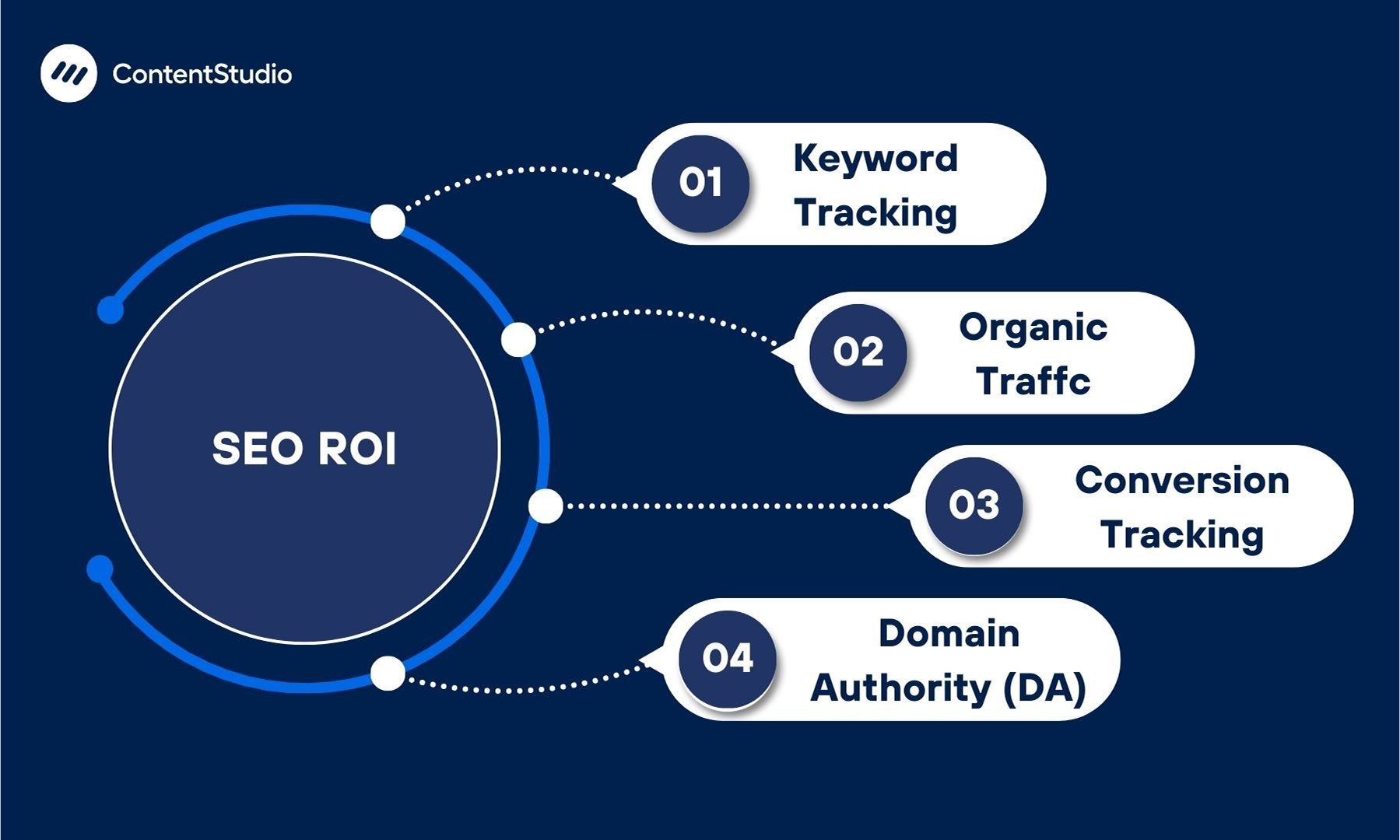
1. Keyword tracking
Monitor the performance of your target keywords using tools like Google Analytics or a specialized SEO platform. Track changes in keyword rankings over time to see how well your content is performing in search engine results pages (SERPs).
For instance, if your blog post on “eco-friendly home tips” climbs from the second page to the top five results in Google, it’s a clear indicator that your SEO efforts are paying off.
2. Organic traffic
Track the amount of traffic your website receives from search engines. Use tools to monitor which pages are driving the most organic traffic and which keywords are bringing visitors to your site.
For instance, an increase in organic traffic to your “sustainable living guide” indicates that your content is effectively attracting search engine users interested in this topic.
3. Domain Authority
Domain Authority (DA) is a metric that indicates how well your site is likely to rank in search engine results. Higher DA means better chances of ranking well. Use tools like Moz’s Domain Authority Checker to track your DA over time.
For instance, if your DA improves from 30 to 40, it shows that your SEO strategies are enhancing your site’s credibility and search engine performance.
4. Conversion tracking
Set up goals to track conversions such as newsletter sign-ups, contact form submissions, or sales directly attributed to organic search traffic. This helps link SEO efforts to tangible business outcomes.
For instance, if your SEO-optimized blog post leads to a significant increase in product purchases, you can attribute this success to your SEO efforts.
Measuring ROI in social media marketing
Social media platforms amplify your content’s reach and engagement, making them vital for content marketing. Here’s how to measure ROI in social media marketing:
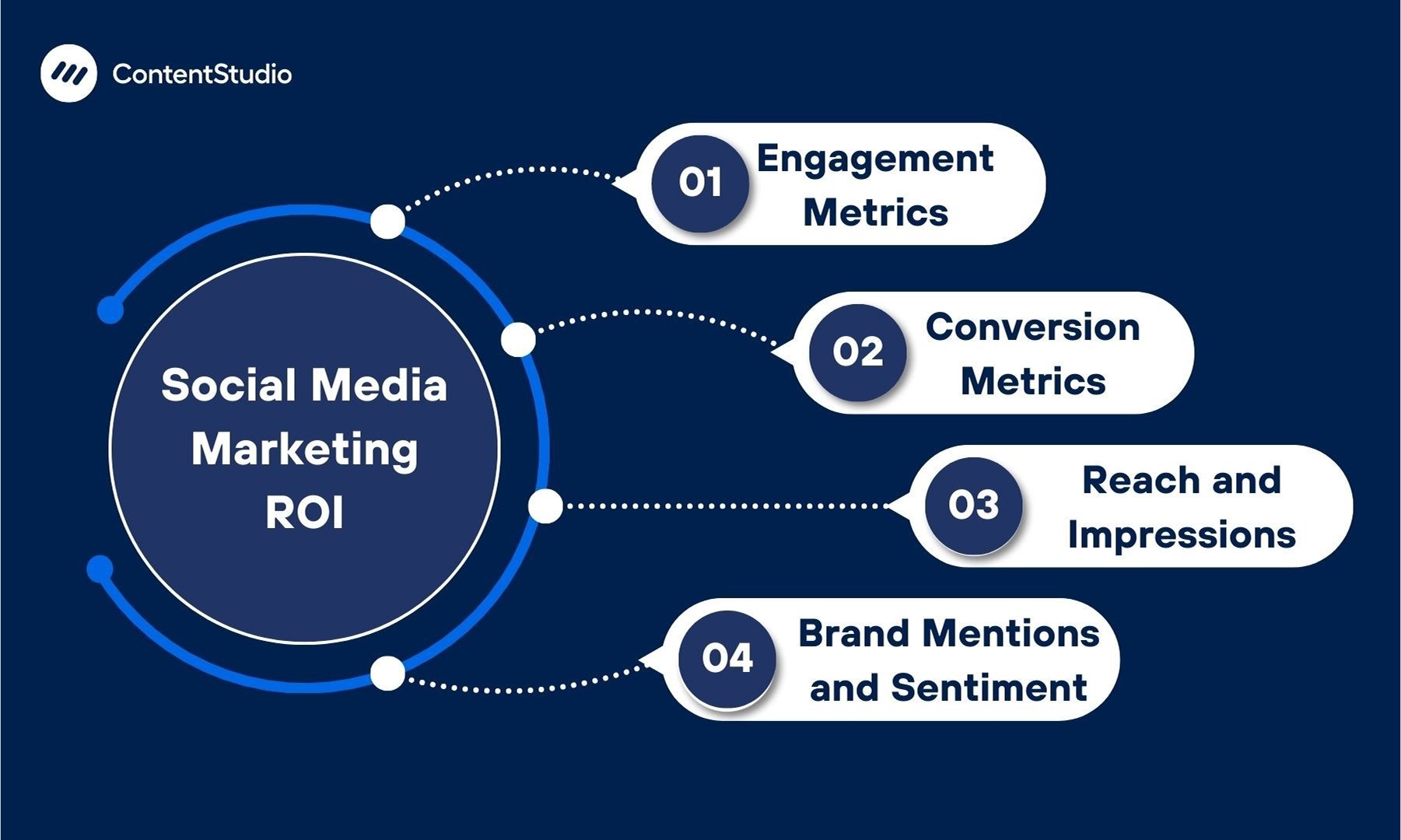
1. Engagement metrics
Track likes, shares, comments, and overall engagement on your social media posts. High engagement indicates that your content resonates with your audience.
For instance, a Facebook post about your new product launch receiving hundreds of likes, shares, and comments suggests strong audience interest and engagement.
2. Reach and impressions
Measure how many people see your content (reach) and how often your content is viewed (impressions). Use built-in analytics tools on platforms like Facebook Insights, Twitter Analytics, and Instagram Insights.
For instance, a Twitter campaign that reaches 50,000 users and garners 100,000 impressions demonstrates extensive visibility.
3. Conversion metrics
Track conversions such as website visits, sign-ups, or sales originating from social media. Use UTM parameters in your links to track these actions.
For instance, if a LinkedIn post generates 50 new sign-ups for your webinar, you can directly attribute these conversions to your social media efforts.
4. Brand mentions and sentiment
Monitor how often your brand is mentioned and the sentiment of these mentions. Positive mentions enhance brand reputation, while negative ones provide opportunities for improvement. Increased positive mentions and engagement around your brand’s social media content reflect growing brand awareness and approval.
Measuring ROI in email marketing
Email marketing remains one of the most effective channels for content marketing due to its direct approach. Here’s how to measure ROI in email marketing:
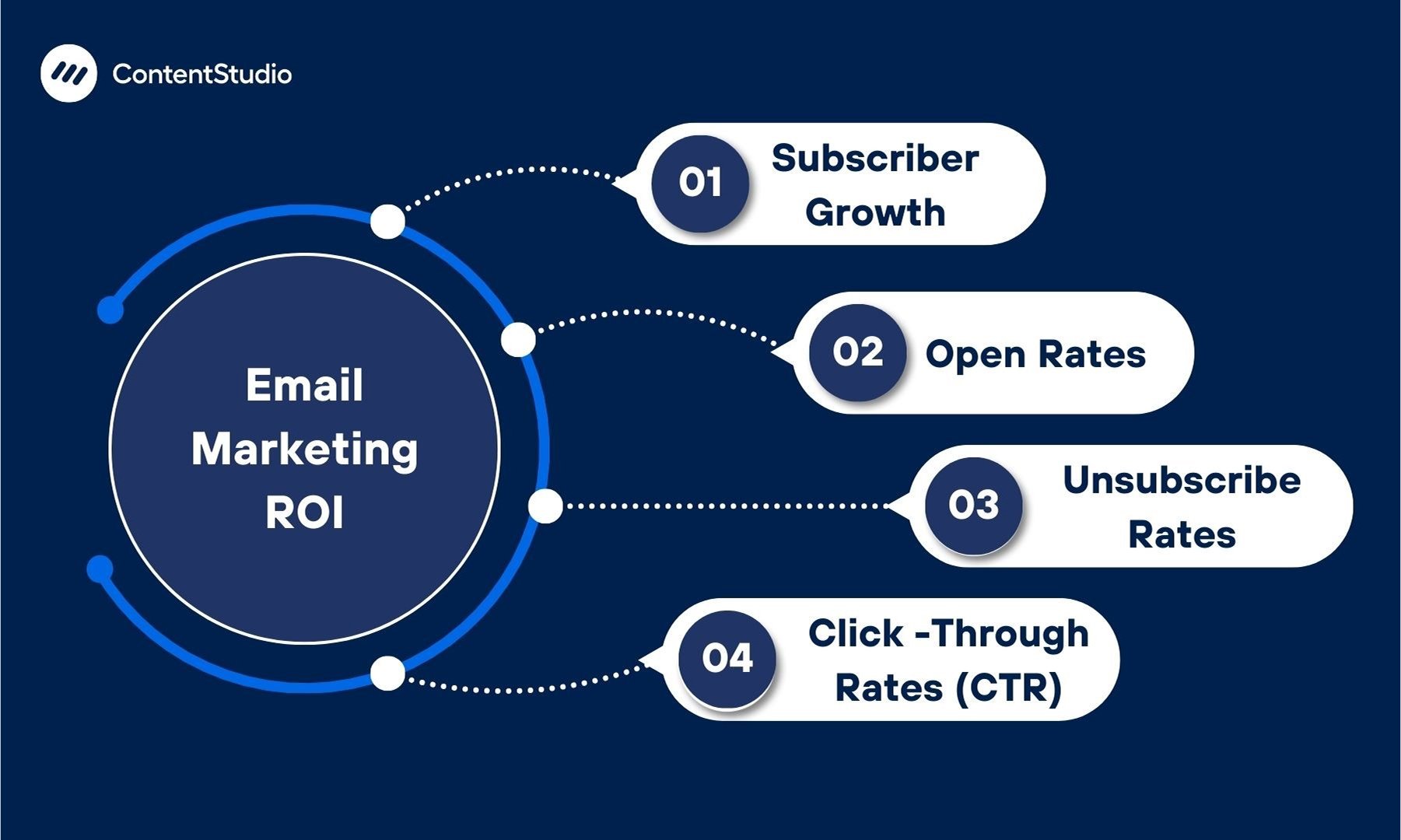
1. Subscriber growth
Track the growth of your email list over time. A steady increase in subscribers indicates that your content is attracting and retaining audience interest.
If your monthly newsletter subscription grows by 20% after implementing a new lead magnet, it shows that your strategy is effective.
2. Open rates
Monitor the percentage of recipients who open your emails. High open rates suggest that your subject lines and sender name are compelling and trusted.
For instance, an open rate of 30% for your latest campaign indicates strong interest and engagement from your subscribers.
3. Click-Through Rates (CTR)
Track the percentage of email recipients who click on links within your emails. High CTRs indicate that your content is relevant and engaging to your audience.
For instance, a CTR of 15% on a promotional email campaign suggests that the content and offers are compelling to your audience.
4. Unsubscribe rates
Track the percentage of subscribers who opt out of your email list. High unsubscribe rates can indicate issues with content relevance, frequency, or value.
If your unsubscribe rate spikes after a particular campaign, it may be a signal to reassess your content or frequency.
Conclusion
The ability to measure ROI in content marketing is crucial, as it ensures your investments are yielding tangible benefits. This guide provides a comprehensive approach to evaluating and improving content marketing ROI, aligning with business objectives, and driving growth.
While measuring ROI can be complex, using the outlined strategies and tools can simplify the process. To deepen your understanding, continue exploring advanced attribution models and analytics tools, and stay updated on industry trends to refine your approach.
The focus on data-driven strategies and precise ROI measurement will only increase over time. Future trends will likely emphasize more advanced analytics and tools, making it easier to connect content marketing efforts with business outcomes.
FAQs
How do we measure content marketing ROI?
Measure content marketing ROI by comparing the revenue generated from content marketing activities to the total investment. Use the formula:
ROI=(Return−Investment/Investment)×100
Track metrics like conversions, traffic, and engagement to quantify benefits.
How do you evaluate marketing ROI?
Evaluate marketing ROI by tracking key performance indicators (KPIs) such as sales revenue, lead generation, customer acquisition costs, and conversion rates. Compare these metrics against the marketing expenses to determine the financial return on investment and overall campaign effectiveness.
What is the KPI in marketing ROI?
The key performance indicator (KPI) in marketing ROI is a metric that measures the effectiveness of marketing efforts. Common KPIs include conversion rates, customer acquisition costs, sales revenue, lead generation, and engagement metrics. These KPIs help assess the financial impact and success of marketing campaigns.
Recommended for you
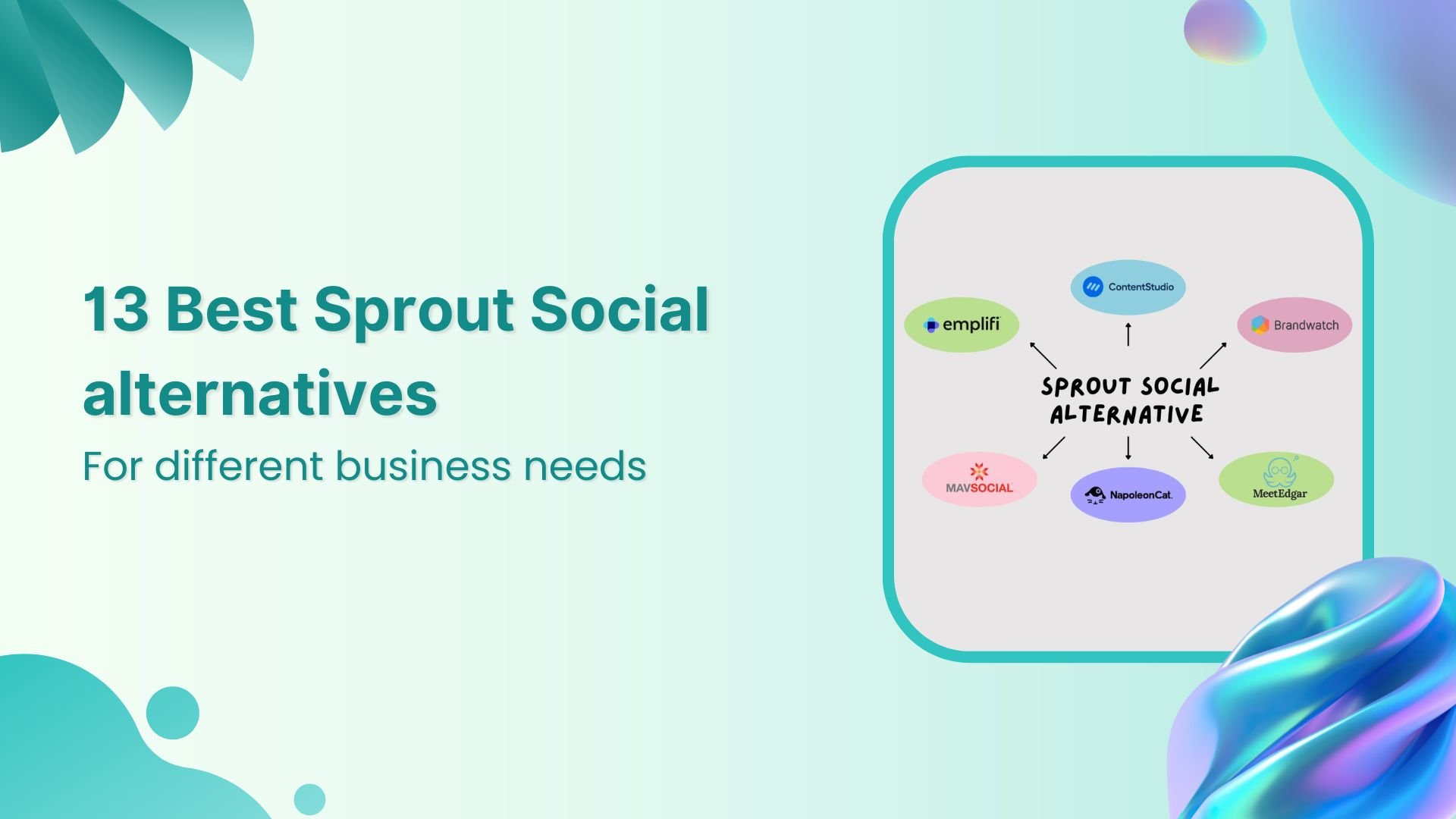
13 Best Sprout Social alternatives for effective social media management

150+ Black Friday quotes, hashtags, and slogans to boost sales

Why is an integrated marketing campaign beneficial for your brand?


Powerful social media management software
14-day free trial - No credit card required.
